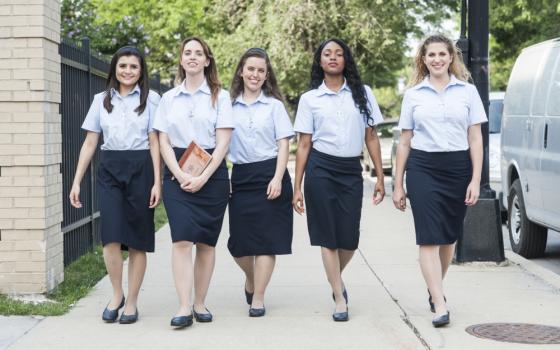Related: Reality TV takes on 'The Sisterhood'
Over the last three weeks, viewers of “The Sisterhood” on Lifetime TV have watched five young women – Christie, Claire, Eseni, Francesca and Stacey – partake in souped-up nun run of sorts. So far, the reality series has documented the five 20-somethings, all considering a vocation, as they lived and served alongside the Carmelites for the Aged and Infirm in Germantown, N.Y., and the Daughters of St. Mary of Providence in Chicago.
During the final two episodes, airing Tuesday night, the women will visit the Sisters of St. Joseph the Worker in Walton, Ky., and it will finally be revealed which of them decided to enter into religious life. (An insider at the show said at least one girls does enter a convent, but that person was not allowed to say which girl(s) or how many, exactly.)
Early criticism of the show has centered, in part, on the fact that the three congregations the women visit in the show are all conservative, habited communities. It’s a complaint that the show’s supervising producer, Linda Corley, a practicing Catholic, said she feels keenly, mostly because some of her first role models were the Adrian Dominican sisters who taught her in school.
“The only thing that was very important to us was to show the broad spectrum of sisters in different ministries of life,” she said, “especially me, who was raised by unhabited nuns.”
Yet, when Hot Snakes Media, the show’s production company, put out the call for congregations to participate, Corley said it wasn’t until she connected with the Institute on Religious Life, a group promoting traditional vocations, that she was able to make any headway. As a result, all the communities from the show are affiliates of the Institute on Religious Life.
“Honestly, we invited the whole world. There was no discrimination whatsoever,” she said. “It’s just the ones that came forward happened to be habited. That’s all.”
Sisters of Mercy were asked to participate in the show, but they refused after being unable to find common ground with Hot Snakes, said Sr. Cynthia Serjak, director of the Sisters of Mercy of the America's new membership office. Still, Mercy sisters are part of a vibrant online community that discusses the show on Twitter each week.
Serjak also blogs a weekly recap of the show. Serjak agreed that “The Sisterhood” lacks diversity when it comes to the featured congregations, but her bigger issue, she said, is the fact that the show does not realistically depict the discernment process.
“The first word that comes to me is ‘disappointment,’” she said about the show, “and yet, I don’t know what I expected. The problem with the way at least most TV works is that they’re looking for things that are dramatic. If someone were to film an actual process, people would probably think it was boring. Because it’s long and it’s very reflective. It’s not made for TV.”
What does seem made for TV, however, are the sisters. When GSR did these interviews, only the episodes featuring the Carmelite sisters had aired, but those sisters had already garnered near universal acclaim for their humor, down-to-earth demeanors and the sage advice they gave to the young women.
Even Serjak, who gives the show two out of five stars, commends the Carmelites.
“I like the sisters,” she said. “The sisters come off as real people, and that’s one stereotype that’s important to break down.”
Audra Turnbull, a 26-year-old Immaculate Heart of Mary candidate agreed.
“I think the sisters portrayed so far have been wonderful,” she said. “They’re very wise, and they’re very respectful of the women, which is what I find in my own community.”
And while she’s not a fan the show’s competitive nature or the seemingly random rules that the discerners are subjected to (they have to wear matching uniforms and aren’t allowed to wear makeup or have cellphones), Turnbull finds herself more open to the idea of their experience than the older sisters in her community.
“There’s parts where I see myself in their journey,” she said – even in the so-called drama.
“I do identify with the freaking out and the crying and all that,” Turnbull said. “I talked a lot to my sisters about that; they’re a little bit more negative about the show, and I think they don’t really understand the openness, because when they entered, they didn’t talk about their feelings.”
But Turnbull, like the five women on the show, is part of the Facebook generation, a generation that has largely normalized the act of broadcasting the intimate details of one’s life – often across multiple media platforms. And it may be that, in the end, addressing that generational divide is the whole point of the show; it may be that the primary concern of “The Sisterhood” is less about the five young discerners and more about the potentially hundreds of thousands of young Catholic women watching at home.
Corley said that when she was pitching the show to the Institute on Religious Life, her argument was this: if women religious want to reach Millennials, they have to speak to Millennials in their language. The message resonated with the Carmelites, who agreed to do the show only after much prayer and consultation with their lawyers.
“Lifetime Television has a membership of 2 million to 3 million women between the ages of 18 and 35, so to open a window to what our life is like to that group of women is an amazing opportunity for us,” said Sr. Maria Therese Healy, one of the Carmelites featured on the show.
“We’re so busy with our ministry, which is so beautiful – caring for the aging, those that are in the process of dying,” she added, “that sometimes we’re not visible to young people. So it’s been an incredible opportunity to get the word out there that we’re still in existence and still continuing to do the ministry of reaching others with the presence of God.”
The Carmelite sisters freely admit that participating in the show stretched them far beyond their comfort zone, but they say they would do it again, noting, however, that contrary to the popular critique, that they were never under any illusion that “The Sisterhood” would depict a full discernment process – although they say all five young women were genuinely discerning God’s call in their life.
But can the show inspire new vocations?
Serjak said that in the two weeks after “The Sistershood” premiered, views on the Sisters of Mercy’s “Become a Sister” page on the website were up 40 percent from the previous two weeks. And views were up 140 percent from the same time last year. Still, the only woman to mention the show just wanted to know how it ended, so Serjak is hesitant to draw a direct correlation.
Turnbull is also not convinced. If women religious want to reach her generation, she said, they need to be bolder. She first met the Immaculate Heart of Mary sisters because they invited her to visit, but that rarely happens anymore.
“I think women religious today have to find courage and believe that their way of life is a viable way of life to Millennials,” she said. “It’s not a confidence issue, but I think some of them have gotten so busy with other things, with fighting injustice, that they’re kind of forgetting to invite women to their communities. I don’t think the invitation is there anymore.”
She doesn’t discount the show’s potential to increase vocations, but she thinks there are also more viable options for women religious.
“It might get a few Millennials to start thinking about it, but our generation is also very socially conscious of what’s going on,” she said, “and I think a way to reach the Millennials is to be on the frontlines of those issues, which women religious are. I’m assuming that they’re probably in Ferguson, they’re in New York, they’re in the streets. They’re there.”
[Dawn Cherie Araujo is staff writer for the Global Sisters Report based in Kansas City, Mo.]

